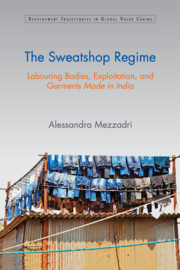Book contents
- Frontmatter
- Dedication
- Contents
- List of Tables, Figures and Pictures
- Acknowledgements
- List of Abbreviations
- Introduction
- 1 The Chain and the Sweatshop
- 2 The Commodity and the Sweatshop
- 3 Difference and the Sweatshop
- 4 The Regional Lord and the Sweatshop
- 5 The Broker and the Sweatshop
- 6 The Body and the Sweatshop
- Conclusions
- References
- Index
Introduction
Published online by Cambridge University Press: 23 July 2017
- Frontmatter
- Dedication
- Contents
- List of Tables, Figures and Pictures
- Acknowledgements
- List of Abbreviations
- Introduction
- 1 The Chain and the Sweatshop
- 2 The Commodity and the Sweatshop
- 3 Difference and the Sweatshop
- 4 The Regional Lord and the Sweatshop
- 5 The Broker and the Sweatshop
- 6 The Body and the Sweatshop
- Conclusions
- References
- Index
Summary
The Sweatshop as a Regime
Every day, as we clothe ourselves, we wear the endless circuits of exploitation at work in garment sweatshops. Who is in charge of these circuits; who is subjected to them; and based on which processes are such circuits created and recreated? To what extent do our jeans, jackets, sweaters and T-shirt hide common stories of exploitation, and to what extent instead do their seams and features conceal the struggles of different working lives, exposed to and consumed by distinct production practices? At its broadest, this book unveils the processes leading to the creation and recreation of the garment sweatshop in India, in the context of greatly differentiated garment commodities and markets. This is hardly a trivial exercise, given that, as astutely observed by Karl Marx (1990, p. 280), employers always carefully and jealously guard the mysteries and secrets of the ‘abode of production’, ‘on whose threshold there hangs the notice “No admittance except on business”’. These mysteries and secrets are particularly numerous in the garment sector, where the ‘abode of production’ is fragmented and organized in composite production circuits connecting different spaces of work and geographical domains. Admittedly, many of such mysteries and secrets – even some of the most repugnant – have been unveiled throughout the last decades by the work of numerous committed scholars, researchers, journalists and activists (recent contributions come from Hoskins, 2014; Seabrook, 2015). Lately, the World Factory has even become the object of a political play interactively illustrating our false commitment to ethical capitalism once this threatens profitability (see Paul Mason's review in The Guardian, 2015). In many ways, one could say that this book simply aims at joining these critical voices by exploring the workings of the sweatshop in India, one of today's great emerging economies whose success is undoubtedly happening on the shoulders of its millions of working poor.
However, while joining the numerous concerned accounts that attempt to describe the sweatshop and its impact, this book also aspires to theorize the sweatshop.
- Type
- Chapter
- Information
- The Sweatshop RegimeLabouring Bodies, Exploitation and Garments <I>Made in India</I>, pp. 1 - 15Publisher: Cambridge University PressPrint publication year: 2016

